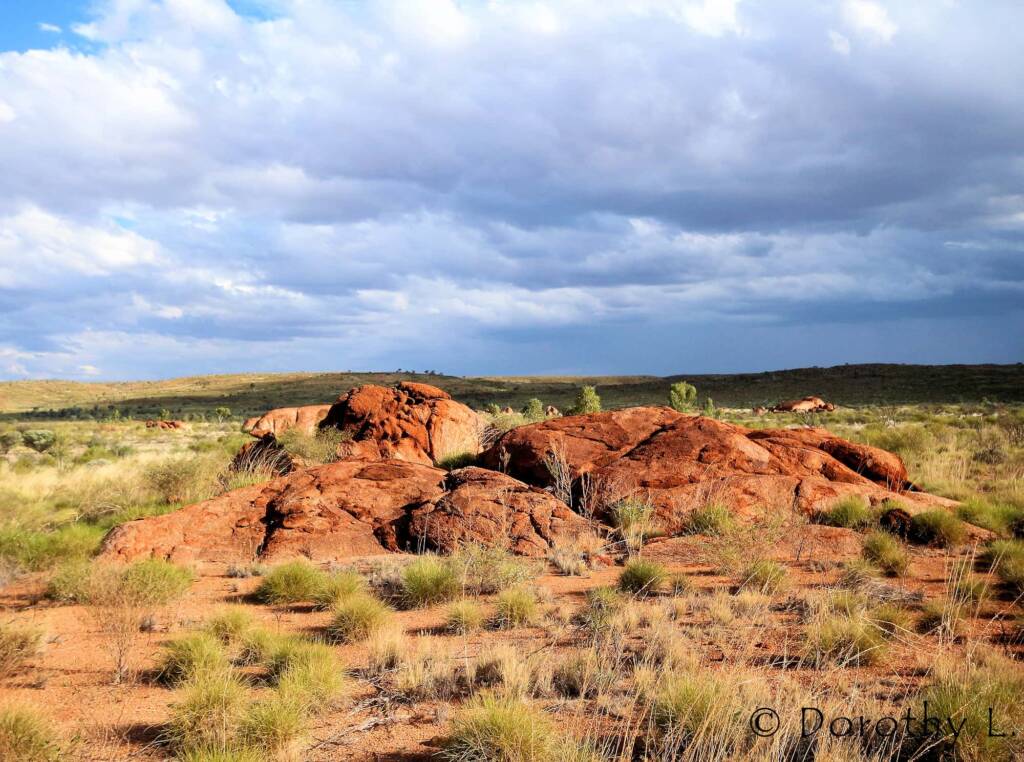Located 393 km north of Alice Springs is the unique formation Karlu Karlu, that literally translate as ‘round boulders’. Karlu Karlu or Karlwe Karlwe (the Warrumungu name), is a living cultural landscape and the traditional country for the Alyawarre, Warumungu, Kaytetye and Warlpiri people.

These ‘marbles’ are located in scattered heaps across the shallow valley region that make up the 1,802 ha of the Devils Marbles Conservation Reserve.
This collection of giant rounded granite boulders, many precariously balanced on top of one another, have over many millions of years been rounded into these oval and spherical shapes by the elements. The marbles were formed from an upsurge of molten rock that cooled and became solid beneath a layer of sandstone. The solidifying granite caused vertical and horizontal fractures, creating rectangular blocks, which over time due to the action of water, wind and sand rounded the boulder to what we see today.




Aboriginal Significance
Karlu Karlu are objects of spiritual and cultural significant to the local Aboriginal people. Located within the country of the Alyawarre people, other local Aboriginal groups, that include the Kaytetye, Warumungu and Warlpiri people, also have spiritual connections and responsibilities for the area.
Karlu Karlu is the place and name for the collection of giant granite boulders within the area they lay. The Alyawarre name for the entire area is Ayleparrarntenhe.
Most of the conservation reserve is a Registered Sacred Site, that is protected under the Northern Territory Aboriginal Sacred Sites Act 1989. In a historic ceremony held here on 27 October 2008, the ownership of the Karlu Karlu / Devils Marbles Conservation Reserve was officially given back to the site’s traditional owners. The reserve is now jointly managed with the traditional owners and Parks and Wildlife rangers.
Dreaming
Karlu Karlu is located on a sacred ‘Dreaming’ site. A story associated with eggs and rainbow serpent is incorrect and whilst there are a number of traditional Dreaming stories, none related to the serpent. The traditional stories are passed on by Traditional Owners through each generation, with only a handful of stories being permitted to be told to the uninitiated.
One of the main Dreaming stories for the area that are permitted to be told to the uninitiated is the one on how Karlu Karlu was created.
Ayleparrarntenhe is the name of the place of origin and final resting place of Arrange the Devil Man — a twin peaked hill to the east of the reserve. Traditional Owners tell the story of how the Marbles came into being:
Arrange, the Devil Man, came from Ayleparrarntenhe and travelled through the area. During his journey, he was making a hair belt (as worn by initiated men). Twirling the hair into strings, Arrange dropped clusters of hair on the ground. These turned into the Karlu Karlu boulders that can be seen today. On his way back, Arrange spat on the ground. His spit also turned into the granite boulders which dot the central part of the reserve. Arrange finally returned to his place of origin, Ayleparrarntenhe.
Devils Marbles Conservation Reserve – JMP Dec08.indd – Northern Territory …, 1 Introduction, p16




Flora & Fauna
The large numbers of granite boulders offer refuges and sheltered environments for the local flora and fauna. There is reported to be 116 plant species (that include 7 introduced species. Flora species include Triodia spicata, T. epactia, T. intermedia, Triodia bitextura, T. longiceps, T. pungens, Eucalyptus leucophloia, Corymbia odontocarpa, Acacia cuthbertsonii and A. adsurgens.
Of the fauna recorded in the reserve, there have been 83 bird species, 10 species of native mammal including 2 bats, 1 dasyurid, 2 macropods, 2 rodents and 1 canid (dingo), 1 monotreme (echidna), 30 species of reptiles, including 27 species of lizard and 3 species of snake, 4 frog species, 1 crustacean (drought-surviving crab Holthuisiana transversa).2
Some of the flora species include the native Rock Fig (Ficus platypoda), Ghost Gum (Corymbia aparrerinja), Bush Banana (Marsdenia australis) and spinifex grasses such as Triodia pungens. You may also catch sight of the small Black-headed Goanna (Varanus tristis) and the larger Sand Goanna (Varanus gouldii). Birds species seen here include the Diamond Dove (Geopelia cuneata), Crested Pigeon (Ocyphaps lophotes) and the Fairy Martin (Petrochelidon ariel). You can see clusters of the Fairy Martin bottle-shaped mud nests attached from the underside of the overhanging boulders. Flocks of birds in the reserve include the Zebra Finch (Taeniopygia guttata) and Painted Finch (Emblema pictum).
Access
The Devils Marbles Conservation Reserve extends along both sides of the Stuart Highway, with the nearest service town being Wauchope 9 km to the south and Tennant Creek 114 km in the north.
Source: Parks and Wildlife Service NT – Devils Marbles
Following images from our Fauna and Flora section are examples of some of the wildlife and flora that may be sighted in the conservation reserve.
Footnote & References
- Devils Marbles Conservation Reserve – Joint Management Plan Dec08.indd – Northern Territory …, 1 Introduction, p16, https://www.nt.gov.au/__data/assets/pdf_file/0020/249050/devils_marbles_JMplan_feb09_introduction.pdf
- Devils Marbles Conservation Reserve – Joint Management Plan Dec08.indd – Northern Territory, 5 Managing Country, https://www.nt.gov.au/__data/assets/pdf_file/0005/249053/devils_marbles_JMplan_feb09_managingcountry.pdf
- Karlu Karlu / Devils Marbles Conservation Reserve, Northern Territory Government, https://nt.gov.au/leisure/parks-reserves/find-a-park/find-a-park-to-visit/karlu-karlu-devils-marbles-conservation-reserve
Northern TerritoryCentral Australia Aileron Alice Springs Binns Track Chambers Pillar Historical Reserve Ernest Giles Road Finke Gorge National Park Henbury Meteorites Conservation Reserve Hermannsburg Historic Precinct Ilparpa Claypans Karlu Karlu / Devils Marbles Conservation Reserve MacDonnell Ranges Mount Connor Newhaven Wildlife Sanctuary Owen Springs Reserve Red Centre Way Drive Standley Chasm Tnorala (Gosse Bluff) Conservation Reserve Uluru-Kata Tjuta National Park Watarrka National Park & Kings Canyon Wurre / Rainbow Valley












